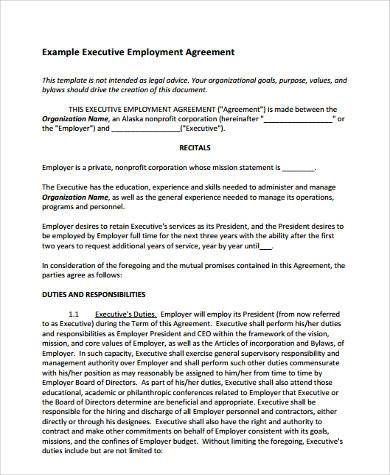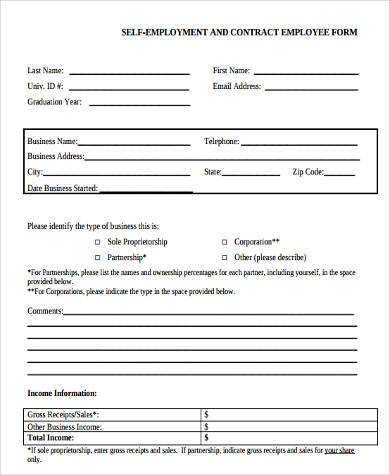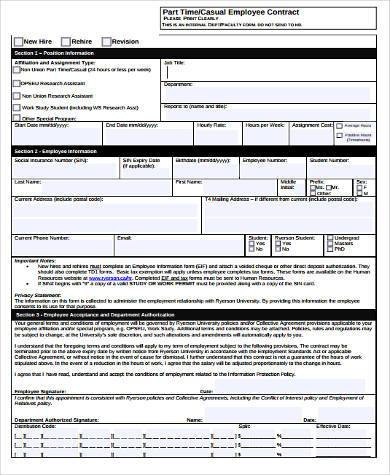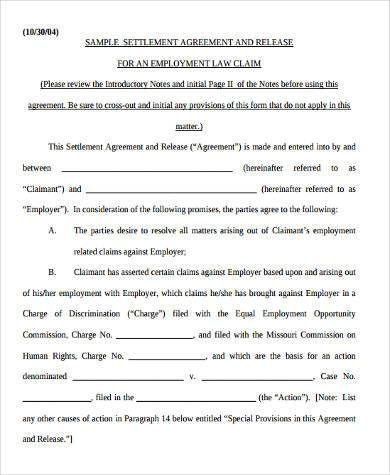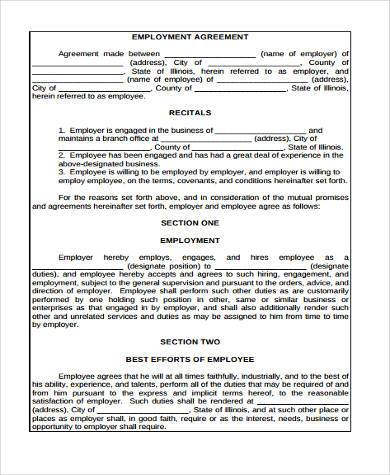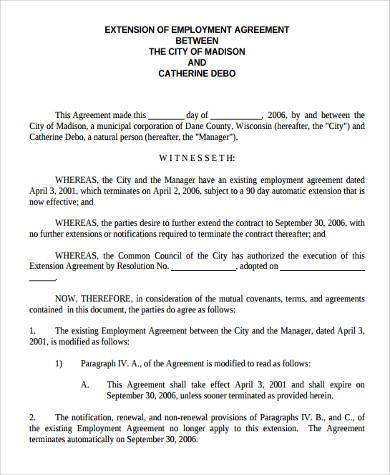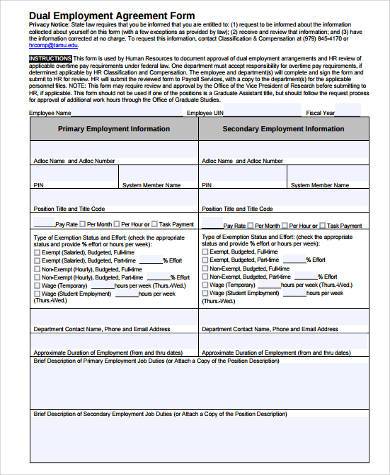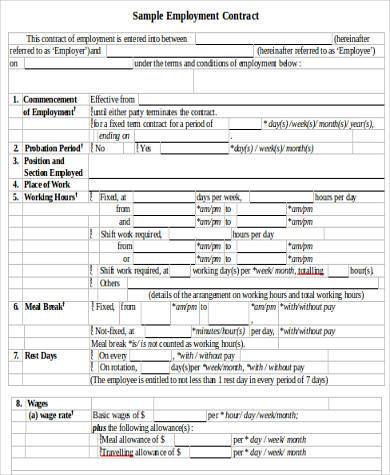An Employment Agreement is a type of contract that is used when an employer decides to hire an employee. Employee Agreements are essential in the workplace because they establish ground rules for an employer and an employee to abide by, and they formalize the hiring of the employee.
Employment Agreements or Employment Contracts typically contain details such as the employee’s name, the employee’s starting date, the amount of salary, schedule and work hours, attendance and leaves, and terms pertaining to the protection of the company’s assets and confidential information.
Executive Employment Agreement Form
Temporary Employment Agreement Form
Self Employment Agreement Form
Part Time Employment Agreement Form
Employment Contract Agreement Form
Employee Contracts and What’s in Them
An Employee Contract is a written and legal document that makes the hiring of an employee enforceable. It is an agreement made between an employer and an employee and states specific details and terms and conditions that obligate both the employer and the employee to follow. Employee Contracts need to be provided upon hiring an employee to protect both parties and create a formality within the hiring process.
Although Employment Contracts are a mainstream type of document in the workplace, it is still crucial that they be drafted carefully and thoroughly. Since Employee Contracts are legally binding, they can be used against an employer or an employee when labor disputes arise. Below is a list of the basic items that need to be included in an Employee Contract or agreement.
Indicate the Names of the Both Parties
An Employment Contract should always begin by stating the name of both the employer and the company or the organization he is going to be connected with.
Start Date
Including the employee’s date of hire will help recruiters, employers, and even employees themselves trace back to the exact date that they started. The start date of the employee is considered to be the date when the contract takes effect.
Job Position
Indicating the employee’s job title makes him aware of what exactly he is going to be doing at work and what are his areas of responsibility. This allows the employer to set expectations for the employee and prepare him for his obligations.
Work Hours
Employees should be given a heads-up as to the number of hours they are expected to work in a day, in a week, or in a month. Most employers require a full-time employee to work at least 9 hours a day, 45 hours a week, and 180 hours a month.
Employment Settlement Agreement Form
Employment Agreement Short Form
Employment Agreement Extension Form
Employment Agreement Form in PDF
Employment Agreement Form Example
Monthly Income
Most employees usually check on the salary being offered by the employer before checking out the rest of the contract. An employee’s monthly income is what makes or breaks an employee’s decision to work with the employer and should be stated in the contract. Deductions, incentives, cut-off schedules, and the date of the month when pay will be given should also be indicated in the contract.
Probationary Period and Regularization
If your company usually goes through a probationary period before regularizing an employee, then the terms have to be properly stated in the contract, such as the duration of the probationary status and the performance criteria that the employee needs to achieve in order for him to be regularized.
It is also important to disclose certain evaluations being done monthly, quarterly, or annually and the corresponding increase of salaries and incentives for good performance.
Attendance and Leaves
Employees missing out on work can cause an encumbrance to the employer. Implementing and establishing rules pertaining to attendance, non-attendance, and tardiness allow an employee to set proper expectations among his employees. The number of sick leaves and vacation leaves should also be stated in the contract to help guide employees regarding attendance concerns.
Non-Disclosure and Non-Compete Clauses
Most employers typically include a Non-Disclosure and a Non-Compete clause within an employee contract. Non-Disclosure Agreements take away an employee’s liberty to confide or divulge sensitive and confidential information about the company to third parties. A Non-Compete clause, on the other hand, bans an employee from working with a competitor or from setting up a company similar to the company of his current employer for a period of time, usually for 1 or 2 years.
Employment Contracts are important documents that should not be taken lightly. Lots of companies have been affected financially due to lawsuits filed by employees because of loopholes found in Employment Contracts. Protect yourself and your company. Our Agreement Forms, Business Agreement Forms, and Personal Agreement Forms provide the most in-depth contracts that cover the important aspects of an agreement.
Related Posts
-
FREE 9+ Sample Release Agreement Forms in PDF | MS Word
-
FREE 29+ Sample Contract Agreement Forms in PDF | MS Word
-
FREE 30+ Sample Purchase Agreement Forms in MS Word | PDF
-
FREE 8+ Sample Joint Venture Agreement Forms in PDF | MS Word
-
FREE 9+ Sample Subordination Agreement Forms in PDF | MS Word
-
FREE 8+ Sample Shareholder Agreement Forms in PDF | MS Word
-
FREE 10+ Sample Transfer Agreement Forms in PDF | MS Word | Excel
-
FREE 8+ Sample Cooperation Agreement Forms in PDF | MS Word
-
FREE 8+ Sample Reaffirmation Agreement Forms in PDF | MS Word
-
FREE 7+ Sample Asset Agreement Forms in PDF | MS Word
-
FREE 7+ Sample Investment Club Agreement Forms in PDF | MS Word
-
FREE 8+ Sample Patent Agreement Forms in PDF | MS Word
-
FREE 10+ Employment Agreement Samples in PDF | MS Word
-
FREE 5+ Rent a Room Agreement Forms in PDF | MS Word
-
FREE 5+ Commercial Sublease Agreement Forms in PDF | MS Word

